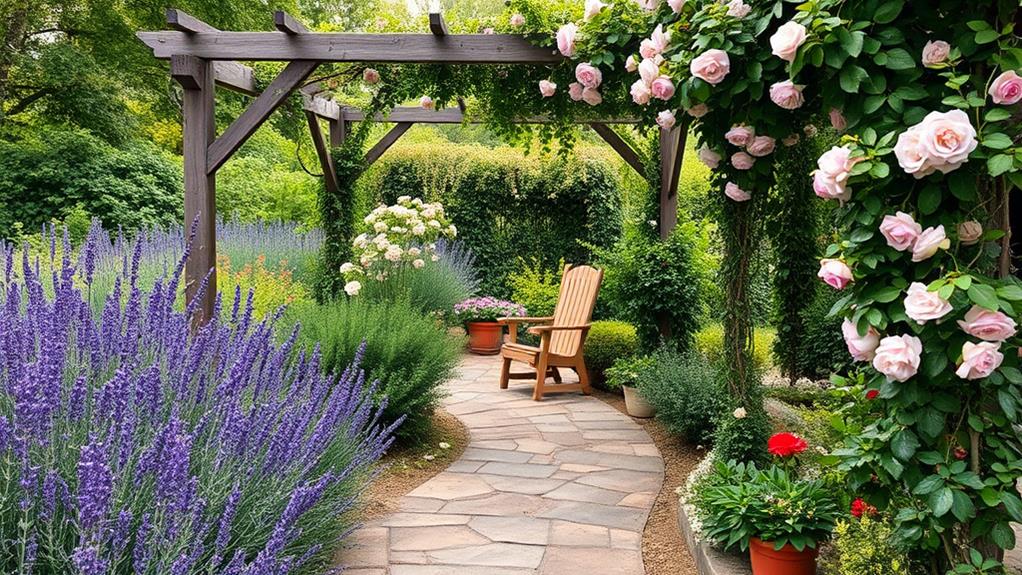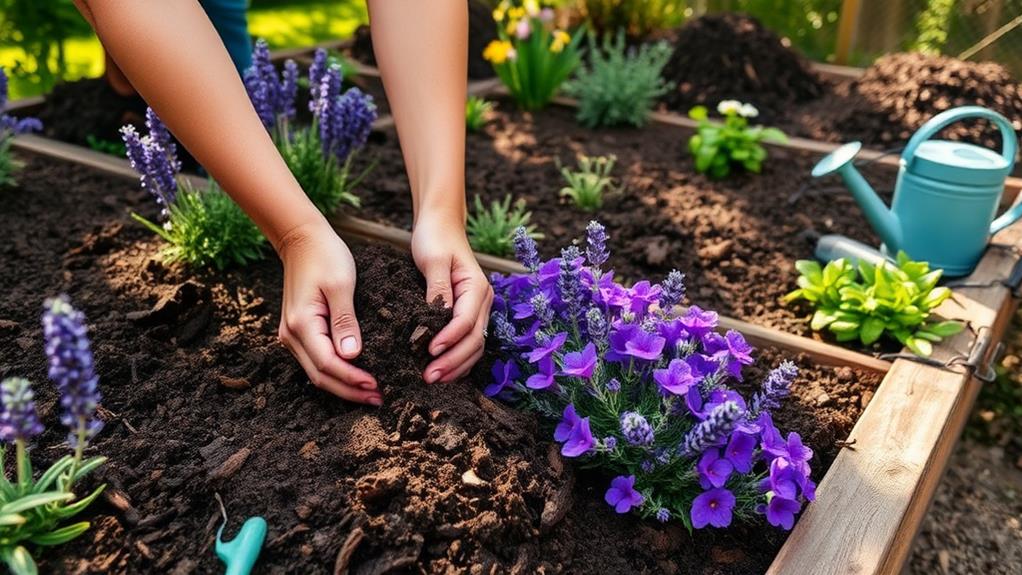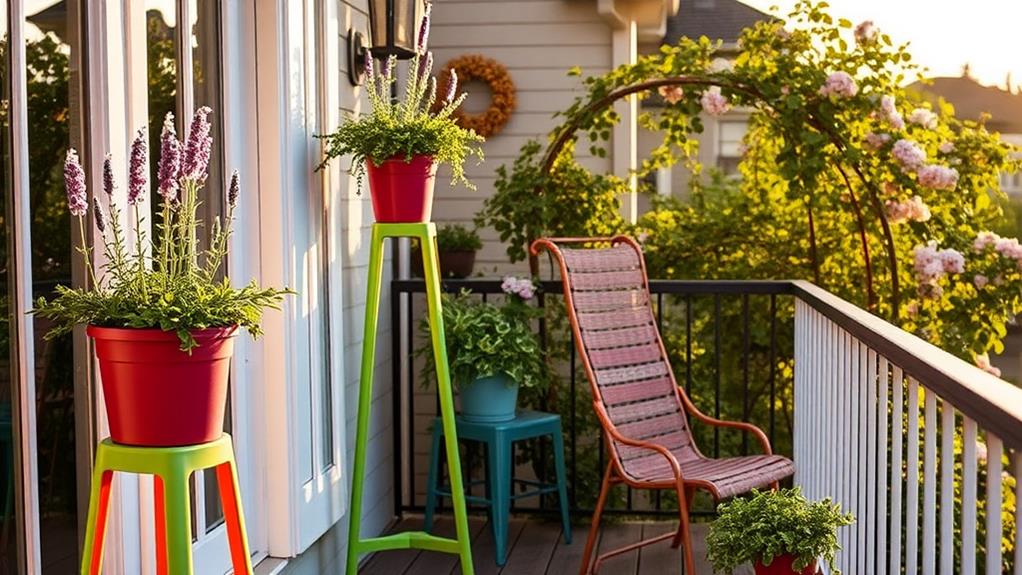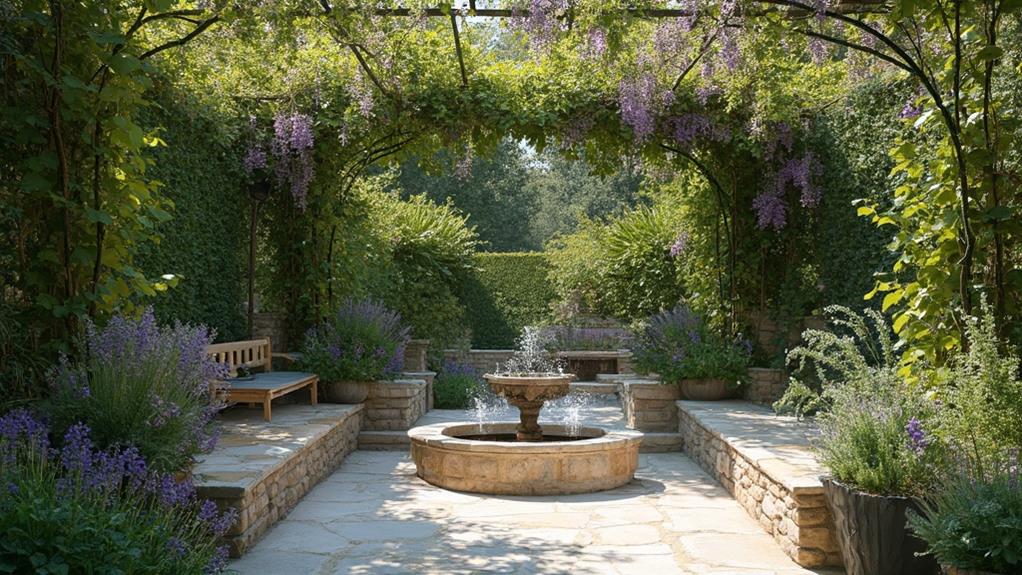Renovating for outdoor aromatherapy involves creating a fragrant garden design that engages the senses. Start by selecting aromatic plants suited to your climate and soil conditions, ensuring year-round fragrance with varied blooming periods. Plan your layout carefully, incorporating meandering paths and distinct fragrance zones. Proper soil preparation and maintenance are crucial for healthy plant growth. Consider container gardens for small spaces, and implement seasonal scent strategies to maximize aromatic impact throughout the year. By thoughtfully designing your garden with fragrant plants, you can transform your outdoor space into a tranquil, scent-filled retreat. Discover how to create your own aromatic oasis and enhance your well-being through nature's perfumes.
Choosing Aromatic Plants

When selecting plants for a fragrant garden, it's essential to choose a variety of aromatic species that will thrive in your specific climate and soil conditions. Consider plants with different blooming periods to ensure year-round fragrance. Popular choices include lavender, jasmine, and roses for their strong, pleasant scents. Herbs like rosemary, thyme, and mint offer both culinary uses and aromatic benefits.
For spring fragrance, plant hyacinths, lilacs, and sweet peas. Summer scents can be provided by gardenias, honeysuckle, and phlox. Fall aromatics include sweet autumn clematis and scented geraniums. Even winter can offer fragrant options with witch hazel and winter honeysuckle.
Consider the placement of plants to maximize their aromatic impact. Place strongly scented plants near walkways, seating areas, or windows to enjoy their fragrances up close. Group plants with similar care requirements together for easier maintenance. Be mindful of each plant's mature size and growth habits to avoid overcrowding. Lastly, ensure proper soil preparation and drainage to support healthy plant growth and optimal fragrance production.
Planning Your Fragrant Layout
With a carefully planned layout, your fragrant garden can become a sensory masterpiece. Begin by considering the garden's overall shape and size, taking into account existing structures and natural features.
Divide the space into distinct zones, each with its own aromatic theme or intensity level. Create paths that meander through these zones, allowing visitors to experience different scents as they move through the garden. Place strongly scented plants near seating areas or entrances for maximum impact.
Incorporate raised beds or terraced areas to bring fragrances closer to nose level and improve air circulation. Consider the bloom times of your chosen plants to ensure year-round fragrance. Group plants with similar watering and sunlight needs together for easier maintenance.
Use vertical elements like trellises or arbors to support climbing fragrant vines, adding depth and dimension to your design. Integrate non-plant elements such as water features or sculptures to create focal points and enhance the sensory experience.
Soil Preparation and Maintenance

A well-planned fragrant garden requires a strong foundation, starting with proper soil preparation and ongoing maintenance. Begin by testing your soil's pH and nutrient levels, adjusting as necessary to achieve a slightly acidic to neutral pH (6.0-7.0) optimal for most fragrant plants. Incorporate organic matter, such as compost or well-rotted manure, to improve soil structure and fertility.
Ensure proper drainage by adding sand or perlite to heavy clay soils. For sandy soils, mix in additional organic matter to increase water retention. Apply a balanced, slow-release fertilizer before planting to provide essential nutrients throughout the growing season.
Maintain soil health through regular mulching, which conserves moisture, suppresses weeds, and gradually improves soil structure as it decomposes. Water deeply but infrequently to encourage deep root growth, and avoid overhead watering to prevent fungal diseases.
Implement a rotating fertilization schedule, alternating between organic and synthetic options to provide a diverse nutrient profile. Regularly remove spent blooms and prune as needed to promote healthy growth and abundant fragrance production. By prioritizing soil health and maintenance, you'll create an ideal environment for your fragrant garden to thrive.
Fragrance Zones and Pathways
Creating distinct fragrance zones and thoughtfully designed pathways is essential for maximizing the sensory experience of your fragrant garden. Divide your garden into areas based on scent intensity and type, allowing visitors to explore different olfactory experiences as they move through the space. Consider placing strongly scented plants near seating areas or entrances for immediate impact, while subtler fragrances can be positioned along pathways or in secluded corners.
Design meandering paths that encourage slow exploration, using materials like crushed gravel or stepping stones to create texture underfoot. Incorporate wider areas for pausing and taking in the scents, perhaps with benches or small patios. Strategically place aromatic plants at different heights along these paths, from ground covers to climbing vines, to create a layered sensory experience.
Consider the time of day when certain plants release their fragrances and plan accordingly. Night-blooming flowers can be placed near evening gathering spots, while morning-scented varieties might be positioned near breakfast nooks or bedroom windows. By carefully planning fragrance zones and pathways, you'll create a dynamic and immersive aromatic journey through your garden.
Container Gardens for Small Spaces

Even in limited outdoor areas, container gardens offer an excellent solution for cultivating fragrant plants and creating aromatic spaces. These versatile arrangements allow you to maximize scented foliage in small yards, balconies, or patios. Choose containers of various sizes and materials, ensuring proper drainage to prevent root rot.
Select fragrant plants suited for container growth, such as lavender, jasmine, lemon verbena, and dwarf citrus trees. Consider the plants' light and water requirements when positioning containers. Group plants with similar needs together for easier maintenance. Layer scents by combining tall, medium, and trailing plants in larger containers.
Utilize vertical space by incorporating hanging baskets or wall-mounted planters filled with cascading fragrant flowers like trailing petunias or sweet alyssum. Place containers near seating areas or entrances to maximize the olfactory experience. For year-round fragrance, include evergreen herbs like rosemary and thyme.
Maintain your container garden by regularly watering, fertilizing, and pruning to encourage healthy growth and abundant blooms. Rotate containers occasionally to ensure even sun exposure and prevent plants from becoming lopsided. With proper care, your small-space container garden will provide a delightful aromatic retreat throughout the growing season.
Seasonal Scent Strategies
Throughout the year, a well-planned fragrant garden can offer a succession of scents that evolve with the changing seasons. To achieve this, gardeners should strategically select plants that bloom and release their fragrances at different times.
In spring, focus on early bloomers like hyacinths, lilacs, and sweet alyssum. Summer brings a wealth of aromatic options, including roses, lavender, and jasmine. For autumn, incorporate plants like sweet autumn clematis and chrysanthemums. Even winter can offer subtle scents with witch hazel and winter honeysuckle.
Consider the placement of fragrant plants to maximize their impact. Position them near walkways, seating areas, and windows to ensure their scents are easily enjoyed. Layer scents by combining plants with complementary fragrances and varying bloom times. Additionally, incorporate plants with aromatic foliage, such as herbs like rosemary and thyme, which release their scents when touched or brushed against. By carefully planning and selecting plants for each season, you can create a garden that provides a continuous olfactory experience throughout the year, enhancing the overall sensory appeal of your outdoor space.
Frequently Asked Questions
How Do Fragrant Gardens Affect Local Wildlife and Pollinators?
Fragrant gardens significantly impact local wildlife and pollinators. They attract beneficial insects like bees and butterflies, promoting pollination and biodiversity. However, certain strong scents may deter some species, potentially altering local ecosystem dynamics.
Can Strong Garden Scents Trigger Allergies or Sensitivities in Some People?
As the breeze carries fragrant wisps, a hidden concern emerges. Strong garden scents can indeed trigger allergies or sensitivities in some individuals. Reactions may range from mild discomfort to more severe respiratory issues, depending on personal susceptibility.
What Are the Best Times of Day to Enjoy a Fragrant Garden?
The best times to enjoy a fragrant garden are typically early morning and evening. Many flowers release their strongest scents during these cooler periods. Additionally, the air tends to be calmer, allowing fragrances to linger and be more noticeable.
How Do Weather Conditions Impact the Intensity of Garden Fragrances?
Weather conditions significantly impact garden fragrance intensity. Warm, humid days enhance scent dispersion, while cold or dry conditions diminish aromas. Wind can carry fragrances further, but strong breezes may dissipate scents quickly. Rain often intensifies certain floral scents.
Are There Any Fragrant Plants That Are Safe for Households With Pets?
Where there's a will, there's a way to create a pet-friendly aromatic garden. Many fragrant plants are safe for households with pets, including lavender, rosemary, and marigolds. Always research specific varieties and consult with a veterinarian for guidance.
Conclusion
Fragrant garden designs offer a multisensory outdoor experience, enhancing both aesthetic appeal and well-being through aromatherapy. Careful plant selection, strategic layout planning, and proper soil management are crucial for success. Creating fragrance zones and incorporating seasonal scent strategies ensure year-round olfactory enjoyment. Notably, studies have shown that exposure to garden fragrances can reduce stress levels by up to 68%. Even small spaces can benefit from aromatic container gardens, making outdoor aromatherapy accessible to a wide range of environments and lifestyles.

